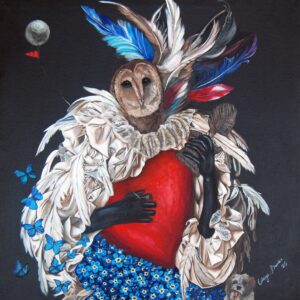The Olympics, a symbol of global unity and the celebration of human excellence, has long been associated with athletic prowess. However, the recent suggestion by Pharrell Williams to reintroduce art competitions into the Olympics has sparked a thought-provoking discussion in the artistic community. This idea not only challenges the conventional boundaries of what the Olympics represent but also aligns closely with the artistic practice of Nigerian artist, Orioye Bukola, whose work embodies the mantra: “questioning the present through the past for a better future.”
A Historical Perspective on Art and the Olympics
The idea of merging art with the Olympics is not entirely new. In the early 20th century, art competitions were indeed part of the Games, with medals awarded for works inspired by sport in five categories: architecture, literature, music, painting, and sculpture. These competitions were discontinued after the 1948 London Olympics, as the lines between amateur and professional artists blurred, raising questions about the spirit of the competition.
Pharrell Williams’ suggestion reignites this historical connection, proposing a platform where art can once again stand alongside athletic achievement. This idea resonates deeply with those who see art as a universal language, capable of bridging cultural divides and addressing contemporary global issues, much like the Olympic Games themselves.
The Intersection of Art and Athleticism
For Orioye Bukola, whose art practice revolves around interrogating the past to create a better future, the idea of an Olympic art competition offers a unique platform to explore these themes. The Olympics, with their deep historical roots and global reach, provide fertile ground for artists like Bukola to engage with and challenge contemporary issues through their work.
Imagine an Olympic art competition where Bukola’s work could address the legacy of colonialism, cultural identity, and the ongoing quest for social justice. Just as athletes push the boundaries of physical possibility, artists like Bukola could push the boundaries of thought and perception, using the global stage of the Olympics to question, provoke, and inspire change.
Art as a Catalyst for Change
Art has always been a powerful tool for social commentary and change. In the context of the Olympics, it can serve as a reminder that the Games are not just about physical excellence but also about the shared human experience. By incorporating art into the Olympics, we could expand the narrative of the Games to include not just the celebration of the body but also the mind and spirit.
Orioye Bukola’s work, which is deeply rooted in exploring historical narratives to inform the present, could contribute significantly to this expanded narrative. His art challenges viewers to reconsider their understanding of history and its impact on the present, making it a perfect fit for an Olympic art competition that aims to address global issues.

One of Orioye Bukola’s recent paintings (Atunbi (Rebirth) Oil and acrylic painting, 24in by 24in by Orioye Bukola)
“Atunbi (Rebirth)” is a vivid exploration of identity, transformation, and the merging of cultural narratives. This painting features an African figurine adorned in a European robe, symbolizing the confluence of diverse cultural influences that shape contemporary identities. The head, bursting with flowers, signifies the blossoming of new ideas, growth, and the flourishing of the human spirit.
The mushrooms held in the figure’s hand represent transformation and regeneration, echoing the themes of rebirth and the cyclical nature of life. Ladybugs, often seen as symbols of luck and protection, fly around the figure, adding a touch of whimsy and suggesting a harmonious relationship with nature.
Through this intricate composition, “Atunbi (Rebirth)” invites viewers to contemplate the continuous process of self-discovery and the beauty of embracing multiple cultural heritages. It celebrates the resilience and creativity that emerge when traditions intersect and evolve, highlighting the transformative power of rebirth in forging a rich, multifaceted identity.
A Vision for the Future
Pharrell Williams’ suggestion, when viewed through the lens of Orioye Bukola’s artistic practice, offers a compelling vision for the future of the Olympics. It proposes a Games where art and sport coexist, each enhancing the other, and together creating a more inclusive and reflective global event.
As the world grapples with complex social, political, and environmental challenges, the reintroduction of art competitions to the Olympics could serve as a powerful reminder of the importance of creativity and critical thinking in addressing these issues. For Bukola, and artists like him, this could be an opportunity to use their work to question the present, through the lens of the past, for the sake of a better future.
In this way, the Olympics could become not just a celebration of what the human body can achieve, but also a celebration of what the human mind can imagine.
Shop any of our Figurines Paintings
And get free shipping of your artworks delivered to your doorstep.
-
 Atunbi (Rebirth)Call for price
Atunbi (Rebirth)Call for price -
 OsainCall for price
OsainCall for price -
 ObatalaCall for price
ObatalaCall for price -
 Aya OsainCall for price
Aya OsainCall for price -
 Whatever You ThinkCall for price
Whatever You ThinkCall for price -
 What About Death?Call for price
What About Death?Call for price

